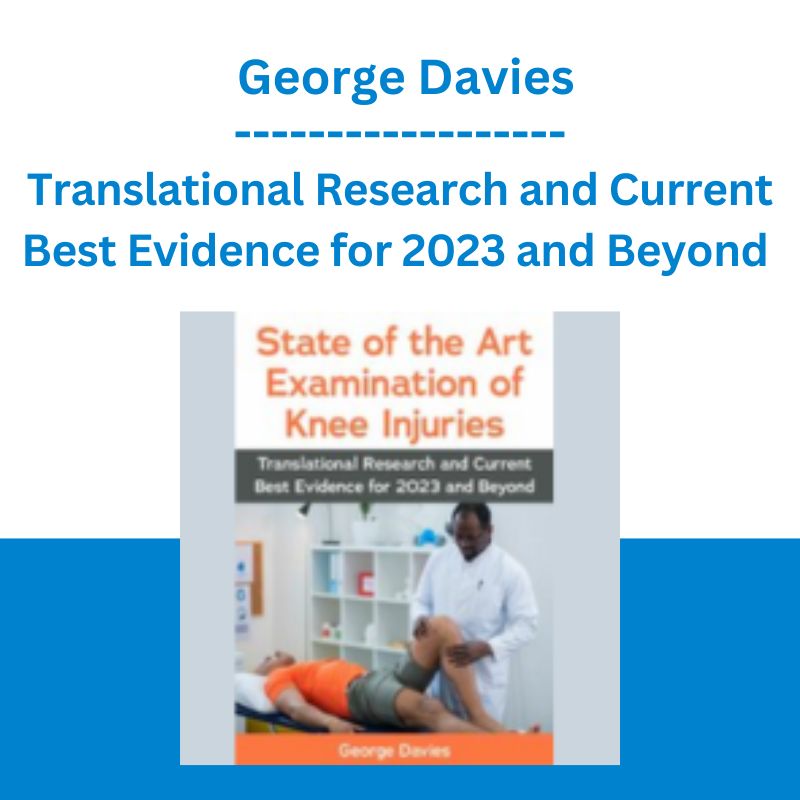*** Proof of Product ***
Exploring the Essential Features of “State of the Art Examination of Knee Injuries: Translational Research and Current Best Evidence for 2023 and Beyond – George Davies”
One of the best ways to help patients is to perform a comprehensive examination to identify the impairments and most importantly, when applicable, the CAUSE(S) of the problem. There are several new evaluation techniques and tests currently being used to establish the subjective, objective and functional data base during the examination of the patient with a knee injury. The scientific and clinical rationale for performing and interpreting these tests will be described and how they guide selected treatment interventions for the patients.
Speaker
George J. Davies, DPT, MEd, PT, SCS, ATC, LAT, CSCS, PES, CES, CSMS, FAPTA, is an internationally known speaker who has presented hundreds of conferences throughout the world on sports physical therapy, athletic training, shoulder, knee, open and closed kinetic chain topics, orthopaedics, rehabilitation and Isokinetics. George is a clinician, educator, speaker, researcher, author, editor, patent holder for exercise equipment and consultant. He has been involved in the clinical practice of sports physical therapy/athletic training, since he was a student athletic trainer, for over 55 years. He has a passion for teaching and has been an educator for over 48 years in colleges and universities.
Dr. Davies has been involved in many research projects that have been presented at numerous national and international conferences and published in various journals. He has participated in hundreds of scientific conferences and workshops throughout the world in the last 45 years. He has published over 200 articles and research abstracts in various periodicals, has written several books and has contributed chapters to over 45 books. George was the original co-founder and co-editor of The Journal of Orthopaedic and Sports Physical Therapy for approximately 10 years. George was also one of the founders and original Associate Editors for Sports Health: A Multidisciplinary Approach for the past 10 years.
Speaker Disclosures:
Financial: Dr. George Davies has employment relationships with Georgia Southern University, Coastal Therapy, and Gundersen Health System. He receives a speaking honorarium and recording royalties from PESI, Inc. He has no relevant financial relationships with ineligible organizations.
Non-financial: Dr. George Davies is a member of the American Physical Therapy Association, the APTA Georgia Chapter, the APTA Wisconsin Chapter, National Athletic Trainers Association, the American Orthopedic Society Sports Medicine, and others.
Objectives
- Determine the components of a comprehensive examination of the knee (which involves the regional interdependency approach).
- Differentiate the best examination tests of the knee based on the best evidence.
- Design the best examination scheme based on the patient’s expectations, best research based on the psychometric properties of the examination techniques, and your clinical experience and expertise.
Outline
EXAMINATION
- Interview Process: Subjective examDemographic Information
- Chief Complaint
- Past History
- History of Present Illness or injury (MOI):
- Medical History:
- Surgical History:
- Subjective Examination: VAS, NPRS
- Laboratory Tests:
- Imaging & Radiology Tests:
- Medications:
- Health Status:
- Social History:
- Systems Review
- CV/Pulmonary System
- Integumentary System
- Neuromuscular System
- Musculoskeletal System
- Communication, Affect, Orientation, Cognition and Learning
- Patient Reported Outcomes (PROs)
- General, Quality of life, condition specific, and joint specific
- Kinesiophobia evaluation (ACL-RSI)
- MUSCULO-SKELETAL PHYSICAL (OBJECTIVE) EXAMINATION TEMPLATE
- Observation/posture
- Integumentary
- Gait Evaluation (Walking/running)
- Related/Referral Joints (Regional Interdependency)
- Anthropometric measurements/LLD
- Palpation (Bones, joints, ligaments, muscle-tendon unit, etc.)
- Neurological Exam: sensation, reflexes, ULTT, LLTT
- Balance/Proprioceptive Testing (static, dynamic)
- Active ROM
- Passive ROM: (Physiological, accessory/component/joint play)
- Flexibility Tests of MTU
- Core testing
- Resisted ROM Testing (MMT, Dynamometer Testing: HHD, Isokinetic Testing)
- Special Tests
- Movement Assessments
- Functional Performance Tests (ADL’s, transfers, mobility, ergonomic, recreational or competitive sport specific)
EVALUATION
DIAGNOSIS (Problem list)
PROGNOSIS
PLAN OF CARE/PT INTERVENTIONS
OUTCOMES (SCALES)(FU TIMES)
Q&A
Please see the full list of alternative group-buy courses available here: https://lunacourse.com/shop/










 Chris Capre - Advanced Price Action Ongoing Training & Webinars
Chris Capre - Advanced Price Action Ongoing Training & Webinars  Team NFT Money - Ultimate NFT Playbook
Team NFT Money - Ultimate NFT Playbook  Julie Stoian & Cathy Olson - Launch Gorgeous - Funnel Gorgeous Bundle
Julie Stoian & Cathy Olson - Launch Gorgeous - Funnel Gorgeous Bundle